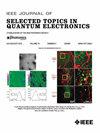一种基于硅基纳米光子功率分路器设计生成的生成逆方法
IF 5.1
2区 工程技术
Q1 ENGINEERING, ELECTRICAL & ELECTRONIC
IEEE Journal of Selected Topics in Quantum Electronics
Pub Date : 2025-01-28
DOI:10.1109/JSTQE.2025.3535573
引用次数: 0
摘要
近年来,基于芯片的光子系统设计已明显转向人工智能辅助的数据驱动方法,而不是传统的基于直觉和仿真的方法。传统的芯片设计方法耗时,再加上其灵活性不足以适应快速发展的集成电路要求,导致了这种情况。在这项工作中,我们提出了一种新的生成模型,用于纳米光子功率分路器的反设计。在1.46 ~ 1.63 μm的任意响应光谱范围内,以1.55 μm为中心波长产生功率分配器。该模型采用机器学习和二次规划求解器,二次规划求解器由线性回归器和混合整数二次规划求解器组成。它是确定性的,因为它的生成器是一个二次规划求解器。我们的经验表明,对于任何给定的任意响应谱,生成的结构的误差范围在10-4%和2×10-4%之间。此外,我们还证明了该模型能够处理和生成分布外响应及其相关设备。我们的代码和数据集可以在这里找到。本文章由计算机程序翻译,如有差异,请以英文原文为准。
A Novel Generative Inverse Approach Towards Silicon-Based Nano-Photonic Power Splitter Design Generation
In recent years, the design of chip-based photonic systems has significantly moved towards Artificial Intelligence-assisted data-driven methods instead of conventional intuition and simulation-based ones. The time-consuming nature of traditional chip-design methods, coupled with their insufficient flexibility to accommodate rapidly evolving integrated circuit requirements, contributes to this situation. In this work, we propose a novel generative model for the inverse design of nanophotonic power splitters. Our proposed model generates power splitters from arbitrary response spectra from 1.46 to 1.63 μm with a central wavelength of 1.55 μm. The model employs machine learning and a quadratic programming solver, which consists of a linear regressor and a mixed integer quadric programming solver. It is deterministic due to its generator being a quadratic programming solver. We empirically show that the generated structures have error margins within 10-4% and 2×10-4% for any given arbitrary response spectra. Furthermore, we also show that the model is capable of handling and generating Out-of-Distribution responses and their associated devices. Our code and dataset are available here.
求助全文
通过发布文献求助,成功后即可免费获取论文全文。
去求助
来源期刊

IEEE Journal of Selected Topics in Quantum Electronics
工程技术-工程:电子与电气
CiteScore
10.60
自引率
2.00%
发文量
212
审稿时长
3 months
期刊介绍:
Papers published in the IEEE Journal of Selected Topics in Quantum Electronics fall within the broad field of science and technology of quantum electronics of a device, subsystem, or system-oriented nature. Each issue is devoted to a specific topic within this broad spectrum. Announcements of the topical areas planned for future issues, along with deadlines for receipt of manuscripts, are published in this Journal and in the IEEE Journal of Quantum Electronics. Generally, the scope of manuscripts appropriate to this Journal is the same as that for the IEEE Journal of Quantum Electronics. Manuscripts are published that report original theoretical and/or experimental research results that advance the scientific and technological base of quantum electronics devices, systems, or applications. The Journal is dedicated toward publishing research results that advance the state of the art or add to the understanding of the generation, amplification, modulation, detection, waveguiding, or propagation characteristics of coherent electromagnetic radiation having sub-millimeter and shorter wavelengths. In order to be suitable for publication in this Journal, the content of manuscripts concerned with subject-related research must have a potential impact on advancing the technological base of quantum electronic devices, systems, and/or applications. Potential authors of subject-related research have the responsibility of pointing out this potential impact. System-oriented manuscripts must be concerned with systems that perform a function previously unavailable or that outperform previously established systems that did not use quantum electronic components or concepts. Tutorial and review papers are by invitation only.
 求助内容:
求助内容: 应助结果提醒方式:
应助结果提醒方式:


